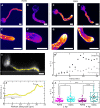An actin mechanostat ensures hyphal tip sharpness in Phytophthora infestans to achieve host penetration
- PMID: 35687685
- PMCID: PMC9187236
- DOI: 10.1126/sciadv.abo0875
An actin mechanostat ensures hyphal tip sharpness in Phytophthora infestans to achieve host penetration
Abstract
Filamentous plant pathogens apply mechanical forces to pierce their hosts surface and penetrate its tissues. Devastating Phytophthora pathogens harness a specialized form of invasive tip growth to slice through the plant surface, wielding their hypha as a microscopic knife. Slicing requires a sharp hyphal tip that is not blunted at the site of the mechanical interaction. How tip shape is controlled, however, is unknown. We uncover an actin-based mechanostat in Phytophthora infestans that controls tip sharpness during penetration. Mechanical stimulation of the hypha leads to the emergence of an aster-like actin configuration, which shows fast, local, and quantitative feedback to the local stress. We evidence that this functions as an adaptive mechanical scaffold that sharpens the invasive weapon and prevents it from blunting. The hyphal tip mechanostat enables the efficient conversion of turgor into localized invasive pressures that are required to achieve host penetration.
Figures







Similar articles
-
A slicing mechanism facilitates host entry by plant-pathogenic Phytophthora.Nat Microbiol. 2021 Aug;6(8):1000-1006. doi: 10.1038/s41564-021-00919-7. Epub 2021 Jul 1. Nat Microbiol. 2021. PMID: 34211160
-
Filamentous actin accumulates during plant cell penetration and cell wall plug formation in Phytophthora infestans.Cell Mol Life Sci. 2017 Mar;74(5):909-920. doi: 10.1007/s00018-016-2383-y. Epub 2016 Oct 6. Cell Mol Life Sci. 2017. PMID: 27714409 Free PMC article.
-
Effect of Flumorph on F-Actin Dynamics in the Potato Late Blight Pathogen Phytophthora infestans.Phytopathology. 2015 Apr;105(4):419-23. doi: 10.1094/PHYTO-04-14-0119-R. Phytopathology. 2015. PMID: 25496300
-
How does a hypha grow? The biophysics of pressurized growth in fungi.Nat Rev Microbiol. 2011 Jun 6;9(7):509-18. doi: 10.1038/nrmicro2591. Nat Rev Microbiol. 2011. PMID: 21643041 Review.
-
Late blight in tomato: insights into the pathogenesis of the aggressive pathogen Phytophthora infestans and future research priorities.Planta. 2021 May 8;253(6):119. doi: 10.1007/s00425-021-03636-x. Planta. 2021. PMID: 33963935 Review.
Cited by
-
Regulation of Intracellular Reactive Oxygen Species Levels after the Development of Phallus rubrovolvatus Rot Disease Due to Trichoderma koningii Mycoparasitism.J Fungi (Basel). 2023 Apr 28;9(5):525. doi: 10.3390/jof9050525. J Fungi (Basel). 2023. PMID: 37233236 Free PMC article.
-
The phase-separating Magnaporthe oryzae MoSpa2 complex organizes actin nucleation centers for plant infection.Plant Cell. 2025 May 9;37(5):koaf097. doi: 10.1093/plcell/koaf097. Plant Cell. 2025. PMID: 40315356
-
Myosin F controls actin organization and dynamics in Toxoplasma gondii.Mol Biol Cell. 2024 Apr 1;35(4):ar57. doi: 10.1091/mbc.E23-12-0510. Epub 2024 Feb 28. Mol Biol Cell. 2024. PMID: 38416592 Free PMC article.
References
-
- P. V. Balhadère, N. J. Talbot, in Molecular Plant Pathology (CRC Press, ed. 1, 2020), pp. 1–25.
-
- Howard R. J., Valent B., Breaking and entering: Host penetration by the fungal rice blast pathogen Magnaporthe grisea. Annu. Rev. Microbiol. 50, 491–512 (1996). - PubMed
-
- Latijnhouwers M., de Wit P. J., Govers F., Oomycetes and fungi: Similar weaponry to attack plants. Trends Microbiol. 11, 462–469 (2003). - PubMed
-
- Rocha R. O., Elowsky C., Pham N. T., Wilson R. A., Spermine-mediated tight sealing of the Magnaporthe oryzae appressorial pore–rice leaf surface interface. Nat. Microbiol. 5, 1472–1480 (2020). - PubMed
LinkOut - more resources
Full Text Sources

